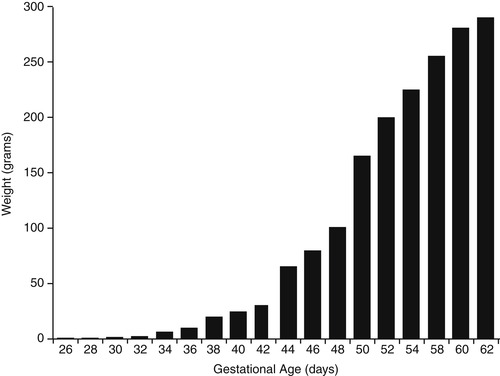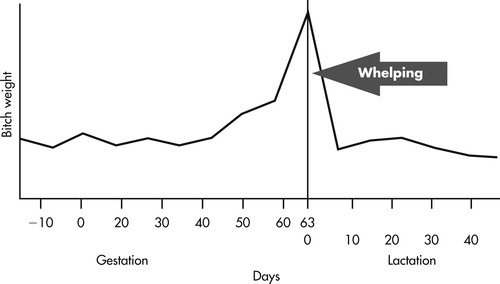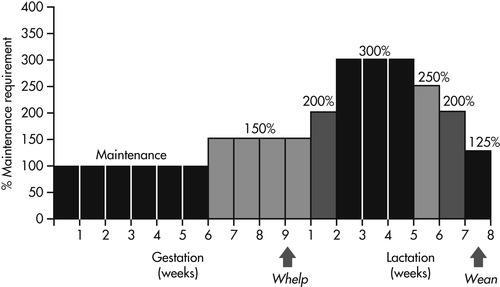Chapter 20. Pregnancy and Lactation
It has been observed that successful gestation and lactation in companion animals is the result of a combination of factors. These factors include selection of healthy breeding animals, use of correct breeding management techniques, maintenance of a healthy environment, and the consistent and long-term provision of a proper diet. 1.2. and 3. Ideally, the correct feeding and management of reproducing animals begins during growth and development of the dam and sire and continues throughout mating, gestation, and lactation (BOX 20-1 and BOX 20-2).
BOX 20-1
Feed a food that is highly digestible and energy- and nutrient-dense.
Do not increase feed intake until the fifth or sixth week of gestation (dogs).
Provide several small meals per day during late gestation.
Increase feed intake to approximately 1.25 to 1.5 times maintenance by the end of gestation.
Dams should gain no more than 15% to 25% of body weight by the end of gestation.
Dams should weigh 5% to 10% above normal body weight after whelping.
BOX 20-2



 Get Clinical Tree app for offline access
Get Clinical Tree app for offline access

Feed a diet that is highly digestible and energy- and nutrient-dense.
Provide adequate calories to prevent excess weight loss.
Provide clean, fresh water on a free-choice basis.
Feed two to three times maintenance during peak lactation.
Provide free-choice feeding or several small meals per day during peak lactation.
Slowly reduce dam’s intake after fourth week of lactation.
PREBREEDING FEEDING AND CARE
The selection of breeding animals should include screening for any faults or anomalies that are believed to be genetically transmissible. 4. and 5. All animals should also undergo a thorough assessment of temperament, structure, and health before being admitted into a breeding program. Conformation shows and various types of performance tests can be used by breeders to evaluate their animals and compare them to established breed standards. Once an adult dog or cat has been selected for breeding, a complete physical examination should be administered. This should include a fecal check for internal parasites, serological tests for brucellosis and herpesvirus in dogs, and the administration of any required vaccinations.
Before breeding, both the sire and the dam should be in excellent physical condition, well-exercised, and not overweight or underweight. It is especially important that the dam be at optimum weight and in prime condition. If the dam is underweight, she may be unable to consume enough food during gestation to provide for her own nutritional needs as well as the needs of her developing fetuses. Lack of proper nutrition in the dam can result in decreased birth weight and increased neonatal mortality. Conversely, an overweight condition in the dam can lead to the development of very large fetuses and dystocia.
At least 2 weeks prior to breeding the queen or bitch should be transitioned (if needed) to a high-quality, highly digestible food that is adequate for gestation and lactation. Changing to this diet early in the dam’s reproductive cycle allows her to be fully adjusted to the new food when breeding takes place and prevents the need to abruptly change diets during either gestation or lactation. Pet foods that have increased nutrient density are needed because of the increased nutrient and energy requirements of reproduction. Feeding a nutrient-dense food allows these needs to be met without excess food consumption, thus avoiding the likelihood of gastrointestinal upset or weight loss. The bitch or queen should be fed this food throughout pregnancy and lactation. For dogs, the food should contain animal-based protein as the primary protein source at a level of 28% to 30% (as fed). 6 Protein level for a reproducing queen should be slightly higher (~32%). 3 Energy density of the food should be relatively high; generally at least 20% fat (as fed) is recommended.
Both omega-6 and omega-3 fatty acids should be supplied in the diet, ideally balanced in a ratio between 5:1 and 10:1. This is important because a female’s essential fatty acid (EFA) status is negatively influenced by the physiological stress of pregnancy and lactation. 7 This risk is greatest in females who have had multiple litters. 8 This occurs because an increased supply of EFAs are needed during gestation and lactation to supply fetal tissues with fatty acids via the placenta and after birth through the milk. Of particular importance to reproducing females and their developing fetuses is the n-3 fatty acid docosahexaenoic acid (DHA). DHA is essential for normal neurological and retinal development in puppies and kittens (see Chapter 21, p. 211). 9 Because adult animals have a limited ability to synthesize DHA from alpha-linolenic acid, the best way to supply developing fetuses and neonates with DHA (and other essential long-chain polyunsaturated fatty acids) is through enrichment of the mother’s diet during pregnancy and lactation. 10. and 11.
A final consideration is the level of antioxidants in the food. During gestation, females experience increased oxidative stress as a result of the increased oxygen consumption and altered metabolism that is associated with pregnancy. 12. and 13. Although limited studies have been conducted with companion animals, one study reported reduced antioxidant status in female dogs during gestation. 14 These changes, when considered in combination with recommendations to increase dietary EFAs during pregnancy, suggest that antioxidant nutrients such as vitamin E, vitamin A, and magnesium should also be increased in foods that are selected for pregnant bitches.
A high-quality, highly digestible food with slightly increased protein and a relatively high energy density should be selected for reproducing bitches and queens. Optimal levels of omega-6 to omega-3 fatty acids are needed, and should be balanced in a ratio ranging between 5:1 and 10:1 and should contain adequate levels of docosahexaenoic acid and other essential fatty acids. The food should also contain sufficient concentrations of antioxidants to offset the oxidative stress that is associated with pregnancy.
FEEDING MANAGEMENT DURING GESTATION AND PARTURITION
Bitches
In pregnant bitches, less than 30% of fetal growth in size occurs during the first 5 weeks of pregnancy. 15 Although the fetuses are developing rapidly, they are very small until the last third of the 9-week gestation (Figure 20-1). As a result, there is only a slight increase in the dam’s weight and total nutritional needs during the first 5 weeks of gestation (Figure 20-2). 16 After the fifth week, fetal weight and size increase rapidly for the remaining 3 to 4 weeks of gestation. In the dog, more than 75% of weight, and at least half of fetal length, is attained between the fortieth and fifty-fifth day of gestation. 17 Although optimal nutrition is important throughout reproduction, it is especially crucial during the last few weeks of gestation to ensure optimal fetal growth and development.
If a bitch is at ideal weight at the time of breeding, no increase in food intake is necessary until the fifth week of gestation. Contrary to popular belief, a bitch should not receive a greater amount of food immediately after she has been bred. An increase of food at this time is unnecessary and could lead to excessive weight gain during pregnancy. It is not unusual for bitches to undergo a transient period of appetite loss at approximately 3 weeks of gestation. However, this change lasts for only a few days and is usually not a health concern. After the fifth or sixth week of pregnancy, the bitch’s food intake should be increased gradually so that at the time of whelping her daily intake is approximately 25% to 50% higher than her normal maintenance needs, depending on the size of the litter and the size of the bitch (Figure 20-3). Her body weight should increase by approximately 15% to 25% by the time of whelping. Using the previous example, a bitch whose optimum weight is 15 kilograms (kg) (33 pounds [lb]) should weigh between 17 and 19 kg (37 and 41 lb) at the end of her pregnancy.
As the developing puppies increase in size, there is a reduction in the abdominal space available for expansion of the bitch’s digestive tract after a meal. Therefore it is helpful to provide several small meals per day during the last few weeks of gestation so that abdominal space does not limit the bitch’s ability to consume an adequate quantity of food. It is important to provide enough food during this period because dams that are underweight during middle and late gestation may have difficulty maintaining body condition for the high demands of milk production that occur during lactation. Likewise, it is also important not to overfeed pregnant bitches. Excessive intake and weight gain will be reflected in heavier fetuses and may result in complications at the time of whelping.
During the later stages of gestation, it is advisable to feed females several small meals per day to ensure that she is able to consume an adequate quantity of food. It is important to provide enough food during this period because dams that are underweight during middle and late gestation may have difficulty maintaining body condition for the high demands of milk production that occur during lactation.
< div class='tao-gold-member'>
Only gold members can continue reading. Log In or Register to continue
Stay updated, free articles. Join our Telegram channel

Full access? Get Clinical Tree





